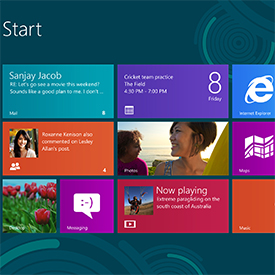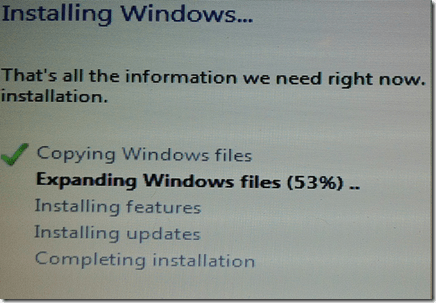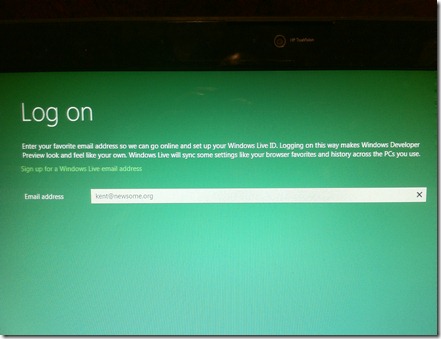 While I was watching Brian Boyko’s hilarious and somewhat accurate and somewhat over the top bash-fest on Windows 8, a few things kept coming to mind. One, while Windows 8 is clearly frustrating, it’s not as bad as all that. Especially since it is, I believe strongly, a transitional OS, bridging the gap between the former desktop world and the future mobile/touch world. Two, every time he raged about the weather app that kept opening, I thought about the way the stupid Mail app on my iMac does that, popping up and begging for me to set up a mail account. I use Gmail via Google Apps. All I need from the Mail app is for it to go away. Third, I kept imagining Ed Bott beating out a response, that I can’t wait to read. It’s hard enough to carry the Windows banner without all the negative hyperbole.
While I was watching Brian Boyko’s hilarious and somewhat accurate and somewhat over the top bash-fest on Windows 8, a few things kept coming to mind. One, while Windows 8 is clearly frustrating, it’s not as bad as all that. Especially since it is, I believe strongly, a transitional OS, bridging the gap between the former desktop world and the future mobile/touch world. Two, every time he raged about the weather app that kept opening, I thought about the way the stupid Mail app on my iMac does that, popping up and begging for me to set up a mail account. I use Gmail via Google Apps. All I need from the Mail app is for it to go away. Third, I kept imagining Ed Bott beating out a response, that I can’t wait to read. It’s hard enough to carry the Windows banner without all the negative hyperbole.
Nevertheless, Brian makes some good points, and this is a worthwhile way to spend 20 minutes.
Without a doubt, the dual interfaces Microsoft jammed into Windows 8 are non-intuitive. I am sure Windows 8 will look and work much better on a Surface Pro than on a legacy desktop. I also expect computer makers will build hardware- eventually- to take advantage of the touch interface. Most of all, I believe the next version of Windows is the one that really matters. It’s a little hard to tell where the operating system is going in 2012. In other words, will everything really be touch based at some point (I guarantee you Apple is thinking about the same thing). It will be clear by 2014 or so. Microsoft is getting a lot of crap for moving too much cheese. Windows 8 seems to me to be a concerted effort to move cheese in stages. I have a hard time faulting Microsoft for that.
And it’s not like some of the problems aren’t shared by other operating systems.
All the hand wringing about the lack of an installation disk, while accurate, is no different than OS X. I needed to do a clean install of Mountain Lion on an iMac the other day because the computer would not stay in target mode (e.g., serving as a second monitor for my primary iMac). It was doable, but not easy. No problem for a computer geek, but impossible for grandma.
At the end of the day, much of the frustration with Windows 8 revolves around the dual Metro (or whatever we’re supposed to call it) and desktop interfaces. Sure, grandma is going to have some trouble getting around Windows 8, but imagine if Microsoft had decided not to “staple” Metro onto the desktop interface, but instead moved all the cheese and dumped the desktop interface altogether? Sometimes you need to take a long journey in smaller segments.
Windows 8 is a big gamble for Microsoft. It doesn’t look like it’s going swimmingly so far, but the game isn’t over. Apple’s computer (as compared to phone and tablet) business is largely consumer based. Sadly for us Mac users in corporate America, Apple doesn’t have to worry about how an upgrade will go over in a huge office with hundreds or thousands of desktop computers staffed by people who only want to create and manage Word documents and Excel spreadsheets. Microsoft has to worry about exactly that. In three years, Windows 8 will be the operating system that set Microsoft’s course into either the future or the ditch. I’m still thinking the future. Not because it is so wonderful, because it’s not. But because it will pave the way for the next version of Windows. That’s the one that will more clearly define Microsoft’s vision for the operating system of the future. I can tell you unequivocally that if you installed Windows 8 in a large corporate office overnight, there would be panic, bedlam and mutiny the next morning. But here’s the thing, you don’t really have to.
Corporate America likes Windows 7, and is not moving away from desktops any time soon. You can be sure Microsoft knows this. The typical large company upgrade path often skips versions (think Vista, for example). It’s the next version of Windows that really matters. That’s where Microsoft needs to pull everything together into an operating system that works intuitively on tablets and desktops, with fingers and mice.
Is is guaranteed? No, it’s not. Microsoft could panic over its passion for the tablet market at the expense of the corporate desktop-oriented market. But I don’t think that’s going to happen.
Appearances and hilarious videos the the contrary.







 There’s been a lot of talk recently about the digital diet that
There’s been a lot of talk recently about the digital diet that